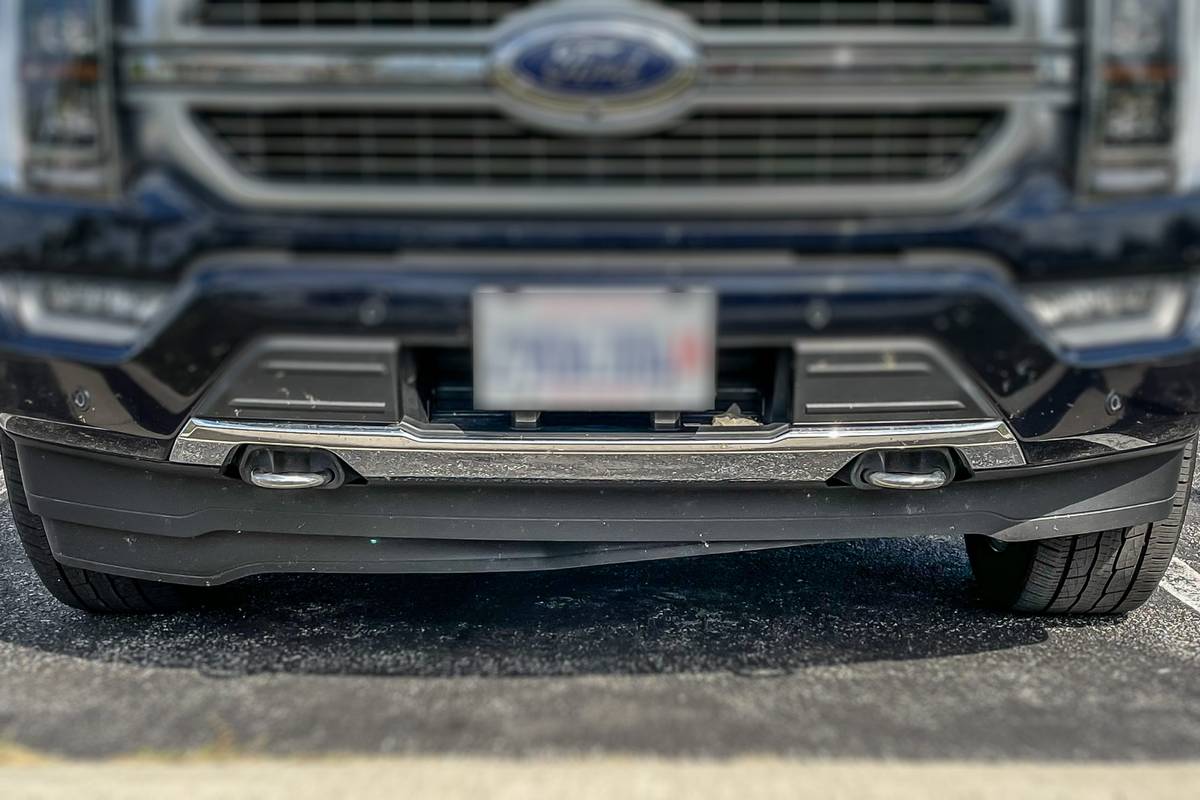Our Long-Term 2021 Ford F-150’s Active Air Dam Was Damaged — Again


Good intentions can lead to unintended consequences, and that seems to be the case with the active air dam on our long-term 2021 Ford F-150 hybrid. Automatically lowering at around 40 mph, the air dam improves aerodynamic efficiency up to 4%, according to Ford.
Better efficiency is a worthy goal for a big, heavy full-size pickup truck, and Ford has worked toward that goal in other ways, too, with features like the F-150’s available hybrid drivetrain. In our experience, however, the active air dam is too easy to damage — and too costly to fix — to be worth its efficiency gains. Especially for a second time.
Related: Our 2021 Ford F-150’s Active Air Dam Disappeared, as Did $1,110 to Fix It
We think some tire debris caused our truck to lose its active air dam assembly the first time, and road debris was the likely culprit the second time around, too. During a real-world fuel economy comparison between our F-150 hybrid and a 2022 Toyota Tundra hybrid, a car in front of the F-150 on the highway drove over what looked like a trash bag of clothes, which then went under the F-150 and hit the lowered air dam. By our measurements, the bottom of the air dam is 5 inches from the road when lowered versus 9 inches when retracted.
Related Video:
The hit caused a portion of the air dam to deform and some of its plastic supports to break. It also meant the air dam would no longer fully retract; while the driver’s side of it would tuck up as it should, the passenger side remained stuck down — and that’s the way it’s been since.

Round Two of Repairs
We called our local Ford dealership to get a repair estimate, but they referred us to a local independent collision repair center instead.
After looking over the damage, the collision center had good news: Only the movable air dam blade seemed to be damaged, while the actuators looked all right. This was great to hear since the actuators alone cost around $460 when we had to replace them the first time. The cost for the replacement air dam blade was $192.95, and with labor and taxes, the total for the repair came to $386.73.
While the repair estimate was significantly less than the $1,100 or so we spent to replace the air dam the first time, it was still hundreds of dollars for something we had already paid to fix once during our ownership. We wondered: By repairing it, were we just setting ourselves up to have to pay to fix it again? We didn’t want to do that.
So, after weighing whether to spend $386.73 to repair it, we decided instead to remove it entirely, which is a common solution other F-150 owners have taken to address problems with the air dam. We asked our local Ford dealer whether they could remove it for us, but they declined. So while the air dam is still stuck at a slanted angle, our plan is to remove it ourselves and take the small efficiency hit so we don’t have to worry about wrecking it again.
When a Good Idea Goes Bad
The F-150’s active air dam has a worthy goal of improving the truck’s aerodynamic efficiency, but it’s poorly executed. It’s too easily damaged, and the repair cost is too expensive to deal with over and over again. We’re done dealing with it, so we’ll be saying goodbye to the air dam soon enough.
More From Cars.com:
- We Charged a Ford Mustang Mach-E With an F-150
- Our 2021 Ford F-150 Hybrid Encounters Failed 12-Volt Battery, Chattering Gear Selector
- What It’s Like to Live With the 2021 Ford F-150 for a Year
- We Rejected Drop-In and Spray-In Bedliners for Our Ford F-150; See What We Installed
- Shop for a Ford F-150
Cars.com’s Editorial department is your source for automotive news and reviews. In line with Cars.com’s long-standing ethics policy, editors and reviewers don’t accept gifts or free trips from automakers. The Editorial department is independent of Cars.com’s advertising, sales and sponsored content departments.

Mike Hanley has more than 20 years of experience reporting on the auto industry. His primary focus is new vehicles, and he's currently a Senior Road Test Editor overseeing expert car reviews and comparison tests. He previously managed Editorial content in the Cars.com Research section.
Featured stories




